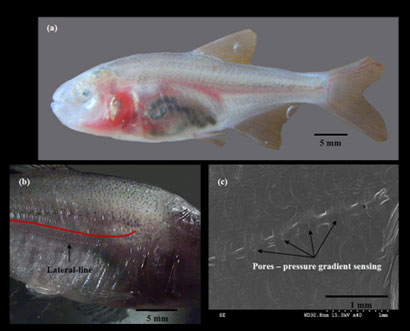Interactions
Have you ever woken up in the middle of
the night to get a glass of water, and tripped over something
that you didn't know was there because of the dark? Now imagine
trying to get this glass of water with absolutely no eyesight,
and no sense of where you were at anytime. This is what the
Astyanax jordani goes through every day of its entire life.
Fortunately for them, they have adapted in ways that allows them
to know their surroundings, and allows them to interact with
organisms it comes into contact with.

One major way this
blind critter know what's going on around them is by using their
lateral line to detect changes in water pressure around them. A
lateral line is a sensory organ made up of neuromasts running along
the head of the fish. These are used to detect movement and
vibration in the water around them. This system allows this species
to actively navigate and find food. When placed into an unknown
environment it will increase its swimming speed to increase the
amount of lateral line stimulation, which ultimately allows them to
become familiar with its surroundings faster.
It has been recently found that these fish produce an intricate
spatial map of its environment, which it memorizes very quickly.
This process is known as hydrodynamic imaging
(Mapoflife.org).
Although this fish doesn't have very many competitive or parasitic
symbioses associated with it, it does interact with other Blind
Cavefish by living in small schools together.
Go Back
Home! Come look at some fun facts
HERE!
Want to see other organisms created by UWL students:
Check out
MultipleOrganisms.net!